The only thing I remember from second grade was my teacher. Mrs. Smith was meaner than a snake with a knot in her tail. I don’t believe that a day went by that she didn’t take one of my hands, palm up, and bend my finger tips toward the floor in preparation for several whacks of her ruler. The experience was much like that of squeezing the trigger of a few concealable, small-framed pistols.
To say that I was pleasantly surprised after running a magazine full of .40 S&W ammunition through Kahr Arms’ CM40 pistol is an understatement. The punishment I expected from such a compact hideout pistol wasn’t there. What I got was a highly controllable, accurate weapon for fighting distances. The pistol, part of the company’s CM series, offers Kahr quality at a lower price point. This is achieved through conventional rifling (rather than the more expense polygonal rifling of other Kahr pistols), an uncoated stainless steel slide, and including a single magazine with the weapon. However, all the quality and performance for which Kahr pistols are known is still present, and in force.
Gun Details
The CM40 as tested has a capacity of five rounds with the grip-flush magazine. Add a round in the chamber and the total capacity rises to six. Extended magazines that hold either six or seven rounds are available. The CM40 weighs 15.8 ounces unloaded and measures 4 inches tall with the five-round magazine (and almost 4.75 inches with the optional six-round magazine). The 0.94-inch-wide slide houses the 3-inch-long barrel, which has a 1-in-16-inch right-hand twist rate. Overall, the pistol is 5.47 inches long.
The CM40 could be considered the “base model” .40 in the lineup. The front sight is pinned to the slide, and the rear sight is drift-adjustable for windage. The front sight has a recessed, painted white dot, while the rear sight features a recessed, white-painted square. A spring extractor is housed on the right side of the ejection port. The slide has gripping surfaces set at a slight angle at the rear to cycle the action. The slide’s finish is matte stainless steel.
The Kahr Arms action follows the Browning locked-breech design featuring a striker-operated firing pin with a passive firing pin safety, making it a true hammerless action. The striker is automatically held under partial tension after each round and is fully secured by a passive striker block until the trigger is fully depressed. When the trigger is pulled, the trigger transfer bar begins to rotate a double-lobed cocking cam. This cam simultaneously begins to draw the striker to the rear, compressing the spring behind it, while depressing and deactivating the firing pin block. At the end of the trigger’s travel, the lobe contacting the striker slips off the striker and releases it; the other lobe has, by this point, completely depressed the firing pin block and permitted the striker to snap forward and strike the primer. It is similar in principle to a Glock-designed action, though very different in execution. It also allows the firing pin block to be located further to the rear of the slide and, therefore, further from possible contamination by combustion gases and powder fouling. For this innovation, company owner Justin Moon was awarded one of the five patents he owns for the Kahr pistol design. This system is employed on all Kahr pistols, regardless of frame material, size or caliber.
The locked-breech action of the CM40 utilizes a tilting barrel design in which the barrel and slide are locked together at the moment of firing. After firing, the barrel and slide recoil to the rear a short distance while securely locked together. The barrel cams downward from its locked position after initial recoil moves the slide to the rear. This permits full recoil of the slide and the extraction and ejection of the spent cartridge case. When the slide returns to its forward position by the recoil spring, the barrel cams back upward into its locked position in the slide.
The CM40’s slide stop is located at the point on the slide that is parallel with the front of the ejection port. It either holds the frame back on the last shot or can be manually raised to hold the slide back. The tool-less takedown pin is located above the trigger. The transfer bar between the trigger and the sear rides inside the right side of the frame. The pistol incorporates a spring-loaded striker that is drawn to the rear by a cam-operated sear. When the trigger is pulled, the striker is drawn to the rear by the sear until it disengages with the rear of the striker. The CM40 does not have an external safety.
Kahr pistol frames are designed to position the shooting hand as close to the centerline of the bore as possible, which provides greater control and a perceived reduction in recoil. Two steel inserts are located in the top rear of the frame to act as guides for the slide. An additional steel insert works to keep the slide centered. Two thinner inner rails are positioned along the inside of the frame to act as guides for the slide as it recoils. The frontstrap and backstrap employ molded checkering, and the grip faces feature molded stippling like other Kahr pistols. The trigger-transfer bar lies in a channel along the inside and left portion of the frame.
The polymer frame mates well with the stainless steel slide, which is characteristic of all Kahr steel-and-polymer pistols. Corners are radiused to prevent snags during use. The CM40’s magazine release is a standard serrated button that conforms nicely to the frame’s lines.

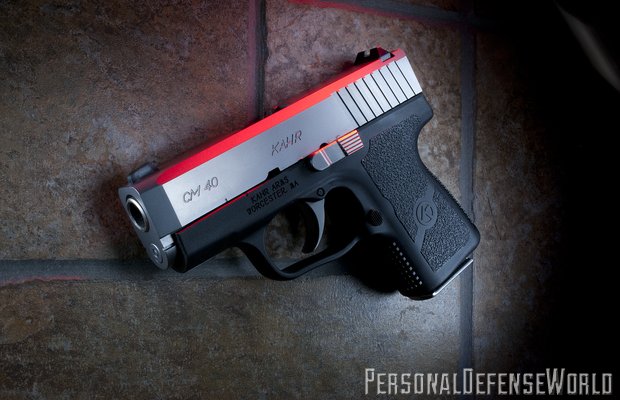
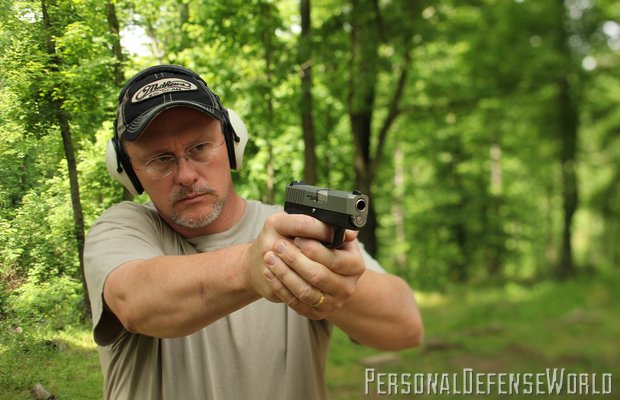

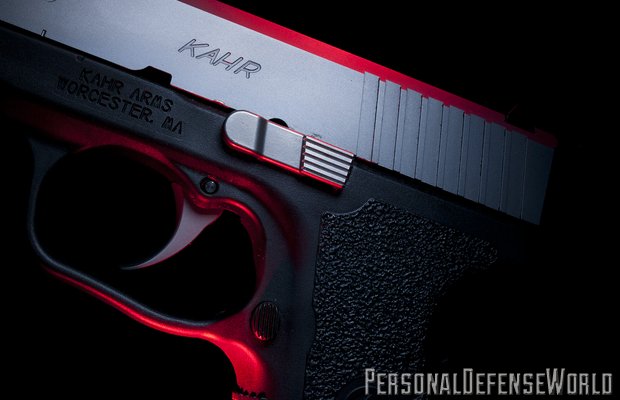
The slide stop, positioned just above the trigger, functioned well during testing. It locked the slide back on the last shot every time.
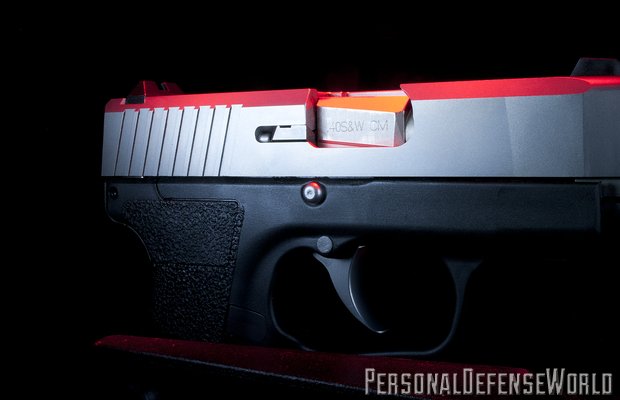
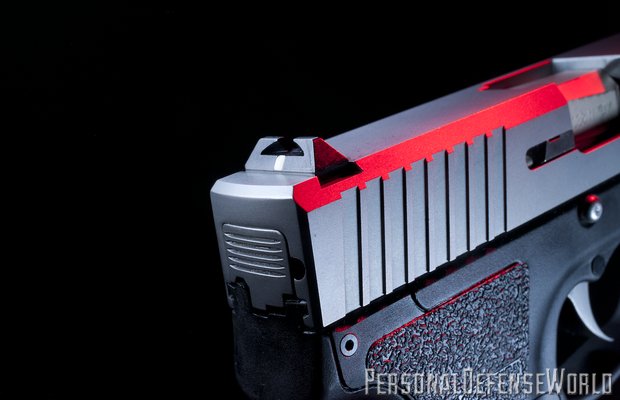
Drift-adjustable for windage, the rear sight is dovetailed into the slide and features a white bar. Note the slide’s cocking serrations.

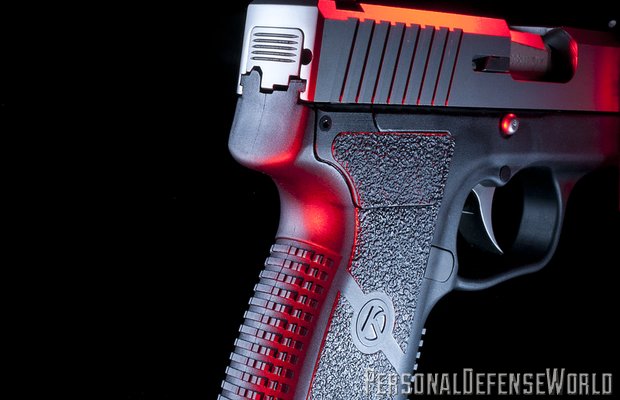
The polymer frame is designed to place the hand close to the centerline of the bore axis, and the grip is textured for better shot-after-shot control.

The front sight, pinned to the slide, has a recessed white dot for aiming. All told, the CM40 is made with concealed carry in mind.





The slide stop, positioned just above the trigger, functioned well during testing. It locked the slide back on the last shot every time.


Drift-adjustable for windage, the rear sight is dovetailed into the slide and features a white bar. Note the slide’s cocking serrations.


The polymer frame is designed to place the hand close to the centerline of the bore axis, and the grip is textured for better shot-after-shot control.

The front sight, pinned to the slide, has a recessed white dot for aiming. All told, the CM40 is made with concealed carry in mind.



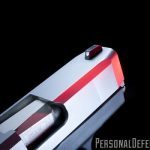
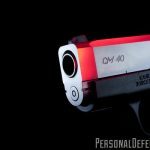
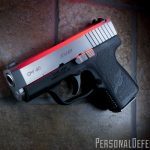
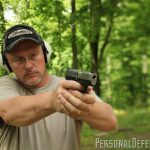
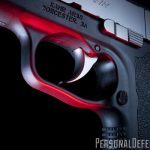
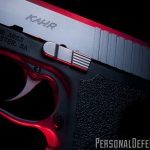
















Range Time
To get comparative insight into the CM40’s accuracy, I tested five loads at 7 yards. Resting on a solid bench, I fired five-shot groups. Velocity data was recorded with an Oehler 35P chronograph. Initially, I tried to gather velocity data with my Shooting Chrony, but it wouldn’t record anything I shot from the CM40. I have had similar experiences with .45 ACP ammunition. It seems that it has trouble capturing the shadow of a short pistol bullet.
I tested five factory loads in the CM40. The first load was Hornady’s 180-grain HAP (Hornady Action Pistol). The listed muzzle velocity for this hollow point is 950 feet per second (fps). From the 3-inch barrel, the ammo averaged 922 fps. The standard deviation was only 4 fps, so the HAP is very consistent with the CM40. The smallest group measured 1.12 inches center-to-center.
I also tried two more Hornady rounds in the CM40: the 165-grain Critical Defense FTX load, with a listed muzzle velocity of 1,175 fps, and their 165-grain Z-MAX ammo, with the same listed velocity of 1,175 fps. The Critical Defense load actually averaged 996 fps and produced a smallest group only measuring 0.85 inches. The Z-MAX load was faster, moving at 1,047 fps, but its smallest group measured 1.12 inches.
The next ammunition was Winchester’s 155-grain Silvertip hollow points. This load averaged 1,073 fps, and its smallest five-shot group measured 1.055 inches. Lastly, I tested another Winchester load, their PDX1 Personal Protection 165-grain jacked hollow point ammo. This load posted an average velocity of 1,007 fps and produced the smallest group overall, at only 0.81 inches.
After putting 200 rounds downrange, my general impression is that recoil from the bantamweight .40 is manageable. If you’re like me and put 125 rounds down the barrel only stopping long enough to reload the five-round magazine, you’ll start to feel the bite in the web of your hand. This isn’t a “fun” gun for plinking, per se—it’s a legitimate backup powerhouse that points and shoots well. I was surprised how well it grouped on 10-Twist steel targets. Shooting with both eyes open, I shot instinctively at 10 yards and kept the five-shot groups all in palm-sized clusters at center-mass.
The trigger pull is long, but that’s the pistol’s sole safety device. While shooting groups, I learned that this pistol tended to shoot left of point of aim until I used my pinky finger as a rest underneath the magazine. The extra stability brought the point of impact back to the point of aim. I even fired a few five-shot groups from my weak hand, and groups didn’t open up appreciably.
Final Thoughts
Obviously, the pistol’s compact grip only allowed me to use three fingers to secure the pistol. If I were to carry this pistol, I would opt for a seven-round magazine with a grip extension to fit my meaty paws. Once you get the feel of the Kahr CM40’s trigger, it’s easy to put rounds on target. The .40 S&W round is effective for defense, and the pistol’s small profile makes it a good concealed carry option. Try it and it won’t take long for you to appreciate the pistol’s small size and power. For more information, visit kahr.com or call 508-795-3919.
